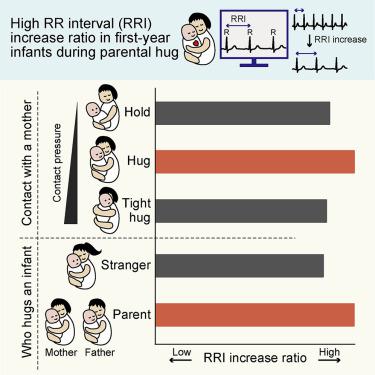iScience ( IF 4.6 ) Pub Date : 2020-04-06 , DOI: 10.1016/j.isci.2020.100996 Sachine Yoshida 1 , Yoshihiro Kawahara 2 , Takuya Sasatani 3 , Ken Kiyono 4 , Yo Kobayashi 5 , Hiromasa Funato 6

|
Caregivers hug their infants to express affection and joy. However, it remains unknown how infants react to being hugged. Here we examined heart rate responses in first-year infants during a hug, hold, and tight hug from parents. Infants older than four months showed an increased R-R interval (RRI) during a hug, indicating reduced heart rates and pronounced parasympathetic activity. Few head movements predicted a higher RRI increase in infants during a parental hug compared with that during a hold and tight hug. Infants did not show an increased RRI during a hug from a female stranger. Infants younger than four months did not show RRI increase during parental hug but exhibited a decreased RRI correlated with contact pressure. Parents showed an increased RRI during hugging their infants. These results suggest the parent-infant hug underlies the parent-infant bonding and psychophysiological development of infants.
中文翻译:

婴儿表现出特定于父母拥抱的生理反应。
保姆拥抱他们的婴儿以表达爱意和喜悦。然而,婴儿对被拥抱的反应如何仍是未知的。在这里,我们检查了父母拥抱,抱紧和紧紧拥抱期间第一年婴儿的心率反应。四个月以上的婴儿在拥抱过程中显示出RR间隔(RRI)增加,表明心律降低和明显的副交感神经活动。与保持和紧紧拥抱相比,很少有头部运动可以预测婴儿在父母拥抱期间的RRI升高更高。在与一个女性陌生人的拥抱中,婴儿的RRI并未增加。小于四个月的婴儿在父母拥抱期间未显示RRI增加,但显示RRI降低与接触压力相关。父母在抱抱婴儿时显示RRI增加。











































 京公网安备 11010802027423号
京公网安备 11010802027423号